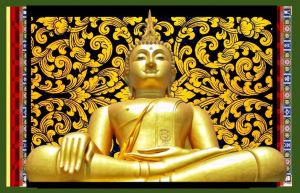How Tantrik Ritual Works
Light on Tantra, Abhinavagupta
In 2015, I published a series of blogs translating the first third of chapter one of Abhinavagupta’s Light on Tantra (Tantrāloka), the most important chapter of that magisterial work. I say ‘most important’ because chapter one summarizes the entire 5800-verse Tantrāloka, which itself is the most comprehensive study of Tantrik philosophy and practice in history.
This year, I return to chapter one, after a hiatus of over two years. Now that I'm working with Ben Williams, Sterling Sanskritist and new Nāropa University professor, I am confident that he and I will complete the remaining two-thirds of the chapter this year, after which we plan to subject it to a careful literary analysis
designed to reveal its hermeneutic brilliance. I am confident that once Abhinava’s thought is better understood, he will be seen as one of the great minds in human history, eclipsing Aquinas and Augustine, and rivaling Kant and Hegel.
The last post in the series was on ‘Universal Patterns of Energy’. Now Abhinava turns to the consideration of how Tantrik ritual works, which will lead him to a consideration of the idea that, whatever God you worship, you're really worshipping Consciousness.
TANTRĀLOKA 1.116-123
The ‘inner self’ of the One Lord who is Consciousness is the creative upsurge of intuitive inspiration (pratibhā), worshipped [by some] as a limited configuration of the [[[infinite]]] Waves of Awareness (saṃvid-ūrmi-chakra), whether gentle or otherwise. || 116
Here Abhinava alludes to the fact that Tantrik praxis exists in two primary forms: a) the invocation and integration of the unlimited aspect of the One Divine Consciousness, whose essence is pratibhā, creative impulse
& intuitive inspiration, for the purpose of spiritual awakening and liberation (bodha & mokṣa); or b) the invocation and manipulation of limited forms of that same power to specific ends (siddhi & bhoga). The second category of practice involves the invocation of Tantrik deities, archetypal patterns of consciousness that are
broadly classified as either gentle (invoked for the purpose of healing and reinvigoration) or fierce (invoked to summon and wield magical power). Of course, those same gentle and fierce deities can be invoked for the
purpose of liberation, but historically the primary reason for the great proliferation of different deity types was primarily in relation to the many worldly goals of those tāntrikas more concerned with b) above. Part of
Abhinava’s project in the Tantrāloka is to convince his audience that Tantra is really ultimate about spiritual liberation and that the latter constitutes a far more effective path to fulfillment than the pursuit of power and pleasures, which are necessarily limited and impermanent.
An alternate translation of this important verse (1.116), following that of Sanderson, would be: “It is the internal creative impulse, the very substance of the unitary Lord who is our Consciousness, that we are worshipping when we worship this or that limited ‘wave’ of Consciousness, gentle or fierce.”
Now Abhinava turns to a discussion of how the second type of Tantrik practice works, seeking to show that though people believe themselves primarily interested in worldly goals, those very goals are only accomplished through activation of Consciousness, thereby implying that through attaining realization of one’s true nature, one attains everything. His example is a ritual of reinvigoration (āpyāyana) for one who is depleted.
Based on a meditative visualization created by [a specific goal], blended with a [[[sacred]]] speech act – [e.g.] “Let this person be reinvigorated!” (asya syāt puṣṭiḥ) – along with a physical ritual act, this Goddess Awareness, becoming increasingly manifest, reveals herself in a form that bestows the fruit of that rite upon him.
For magical ritual to be effective, it must involve body, speech, and mind: the three primary modes in which Awareness engages and expresses. These three are united by a singular intention. Even though the ritual act may
be meaningless, the very fact that one articulates one’s intention in action has an effect (this is a key principle behind both Chaos Magick and Jodorowsky’s ‘psychomagic’). The more elaborately and precisely orchestrated the ritual action, the more powerful the effect. Now this effect may be a placebo effect, but let's
remember that the latter is very real and actually can bring about healing. In the verse, Abhinava acknowledges that it is the activation, intensification, and directing of Awareness that brings about whatever effect the ritual achieves.
The Reinvigoration rite consists of ‘inundating’ a [[[person]] who is spiritually or physically] ‘parched’; so since water is translucent white, the visualization [of the Deity] is performed accordingly, with that [[[Wikipedia:color|color]]] as primary. || 118
In other words, there must be logic to the ritual. For healing and reinvigoration, one visualizes the deity (in this case, Amrteśvara and Amrta-Lakshmī) in a translucent white light-body, because that corresponds to the color of refreshing nectarean water.
